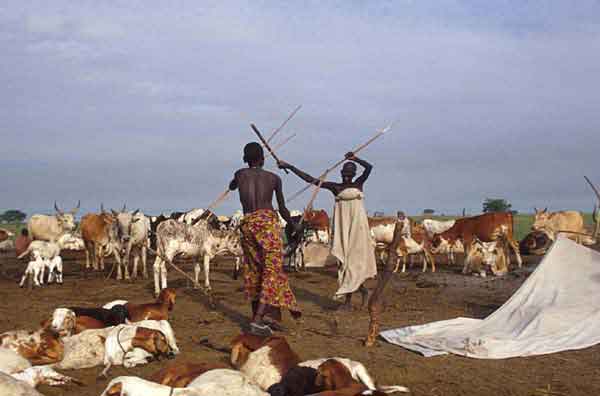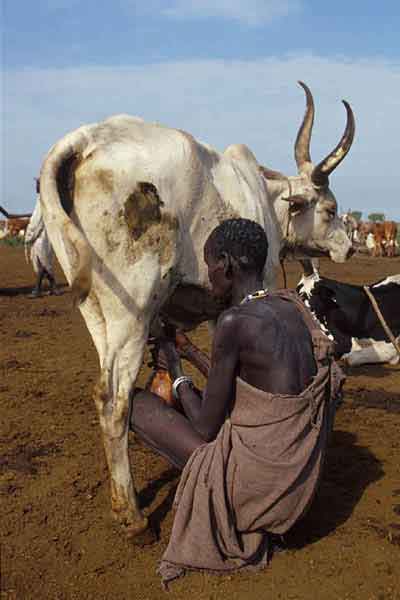It is now generally recognized by rinderpest epidemiologists that, when it comes to these situations of stable endemic persistence, rinderpest eradication only really commences once mass vaccination is abandoned.
Background to the current rinderpest situation in Africa
Routine vaccination programmes throughout Africa have undoubtedly served to protect large numbers of cattle from the effects of rinderpest and reduced the incidence of the disease over many years. In many countries this was sufficient alone to interrupt virus transmission. However, control programmes based on routine vaccination have failed to eliminate a small number of residual foci of endemic rinderpest infection which persisted throughout JP15 (Joint Project 15 - the first internationally coordinated attempt to rid Africa of rinderpest) and afterwards. Following JP15, in the 1980s, in what is sometimes referred to as the second great African pandemic, rinderpest virus from the Sudan spread through Central Africa to West Africa, to meet up in Nigeria with rinderpest virus spreading eastwards from an endemic focus in the pastoral herds of Mauritania and Mali. Much of sub-Saharan Africa was devastated by the pandemic. Since that time, large areas of West Africa, for example, have been cleared of rinderpest with the last known outbreaks occurring at the Burkina Faso/Ghana border in 1988. However, the reservoirs of infection in eastern Africa have proved more difficult to eliminate.
It is now clear - as demonstrated again by the Pan-African Rinderpest Campaign (PARC) of 1986 to 1999 - that routine, annual, mass vaccination programmes cannot be relied on to eliminate rinderpest from its last strongholds in extensive pastoral communities. This is partly related to the dynamics of the livestock populations in which the virus persists, but it is also a factor of the remoteness and relative inaccessibility of at least a proportion of the population involved. In these circumstances, it is extremely difficult to generate a broad herd immunity level exceeding 70 percent; 60 percent or even far less is usual. This depresses the impact of the disease but also serves to maintain a situation of endemic persistence within which the virus may be difficult to detect for much of the time.
Experiences in other countries, and most notably in Ethiopia, serve to illustrate how this situation of endemic persistence can be overcome. Despite maintenance of annual vaccination campaigns that reached up to one-third of the entire cattle population each year, rinderpest occurred continuously in Ethiopia into the 1990s. Epidemiological studies in the early 1990s demonstrated a pattern of epidemic extensions of rinderpest from endemic reservoirs of infection that were based in extensive and remote pastoral communities. Recognizing the implications, an innovative approach has been implemented by PARC-Ethiopia since 1993. The approach taken was to cease annual routine vaccination in areas that served only as epidemic indicator areas of infection elsewhere. Instead, efforts were concentrated on intensive vaccination of the herds in which the virus was persisting, employing a combination of conventional and community participatory programmes, and on strengthening early warning (based on surveillance) and ensuring early reaction to rinderpest outbreaks. The strategy was tested rigorously during 1994 when an epidemic of rinderpest occurred in the highlands. Although it took more than six months to arrest, its spread was relatively slow and caused little real damage, even though it moved into Eritrea. Despite this setback, within two years rinderpest was eradicated. Similar experiences from other countries reinforce the lessons learned in Ethiopia.
It is now generally recognized by rinderpest epidemiologists that, when it comes to these situations of stable endemic persistence, rinderpest eradication only really commences once mass vaccination is abandoned.
Current status of rinderpest in the Sudan
In recent years, concerted action by all organizations providing veterinary services in the Sudan has markedly reduced the incidence and distribution of rinderpest and has made significant progress in clarifying the rinderpest epidemiological situation. The last confirmed outbreak occurred in Eastern Equatoria State in mid-1998 and was confirmed to have been caused by Lineage 1 (Africa) rinderpest virus (sequenced at the FAO/International Office of Epizootics [OIE] World Reference Laboratory for Rinderpest). Prompt control measures, including intensive, focused vaccination by community animal health workers from non-governmental organizations, controlled the outbreak. Since that time no other cases of clinical rinderpest have been detected in southern Sudan despite active investigation of numerous disease incidents reported through the community-based animal health programmes. However, until it can be proved that rinderpest is no longer present in the southeast of the country (bordering Ethiopia, Kenya and Uganda), it is prudent to act on the basis that rinderpest could still be present there. The significant populations of cattle in that area are difficult to access for the purposes of disease surveillance and vaccination. Elsewhere in the Sudan, a comprehensive participatory survey of livestock herders during 2000 provided strong evidence to support the belief that rinderpest has not extended out of the southeast since 1995 or even earlier (FAO Technical Cooperation Programme Project TCP/SUD/8923).
Rinderpest - control versus eradication
Clearly, rinderpest control in the Sudan has now reached the point where eradication can be envisaged as feasible in the near future. Pragmatically it must be realized that it will never be possible to immunize the entire cattle holdings of the pastoralists of southeastern Sudan at one time to a level where virus transmission is interrupted. With existing, or even improved, vaccination practices and the resources that are likely to be available, herd immunity levels are unlikely ever to reach, let alone exceed, some 30 to 50 percent of the cattle population. The inevitable result is that rinderpest will persist in endemic form and cause constant, repeated attrition of the herds and occasional epidemics of variable severity unless an alternative approach is found. The incidence of rinderpest outbreaks would certainly be reduced to a degree by such a vaccination campaign approach, but the risk of epidemics would remain high and cause alarm, if not actual losses, each time that climatic or human-induced crises caused unusual livestock migrations, mixing of herds and crowding. Thus routine vaccination would have to be continued forever.

Cattle camp in the western Upper Nile of the Sudan
PHOTO COURTESY OF MARC BLEICH
Certainly the agencies providing animal health services to livestock owners in southern Sudan have a duty to protect their cattle from the devastating effects of rinderpest, and it could be conceived that this requires continuation of provision of rinderpest vaccination. However, the interests of the families dependent on cattle would be far better served by eradication rather than perpetual control, which creates a situation of continuing vulnerability from rinderpest resurgence in the face of suboptimal protection and lapses in service provision. The vulnerability refers not only to the Sudan but also to the many millions of cattle-dependent families in neighbouring countries in the Horn of Africa. It should not be forgotten that eradication is forever, whereas control is neither absolute nor permanent. Control only has an effect as long as vaccination programmes can be maintained. With the turnover of cattle in the population, susceptibility soon reverts to preimmunization levels as soon as the vaccination campaigns lapse.
Once rinderpest is eradicated, the way is clear to invest resources in control of the other major diseases that cause serious losses, such as contagious bovine pleuropneumonia (CBPP), contagious caprine pleuropneumonia and peste des petits ruminants (PPR).
Continuing suboptimal vaccination not only serves to maintain endemic persistence and to mask the presence of rinderpest but it also seriously compromises the use of serological studies to disclose the presence of rinderpest (serosurveillance). Vaccination must cease for progress to be made.

The vulnerability refers not only to the Sudan but also to the many
millions of cattle-dependent familiesPHOTO COURTESY OF MARC BLEICH
Actions proposed
The Sudan should now consolidate and build on the progressive control of rinderpest achieved so far by embarking on the final eradication thrust. Eradication is not that much more demanding than control but it does require a different mindset. Given commitment to the objective by all concerned, it is likely that the goal of eradication could be achieved rapidly - well within two years. It is expected that the Interafrican Bureau for Animal Resources (IBAR), through the regional and national elements of the Pan African Campaign against Epizootics (PACE) programme, and in close collaboration with the Global Rinderpest Eradication Programme (GREP), will give the technical lead needed.
Elements of the actions required to focus on the target of rapid eradication while protecting the cattle-dependent communities are:
- the basic health care required to support livestock-dependent food security,
- early warning of rinderpest outbreaks,
- epidemiological definition of rinderpest persistence,
- ensured early reaction capacity for rinderpest outbreaks,
- focused immunization for eradication in identified areas of virus persistence;
The community-based livestock services in southern Sudan have proved that they are capable of providing the required system of early warning and reacting rapidly in an emergency, provided that a minimum infrastructure is maintained. The challenge to all concerned parties is to intensify programmes to access those communities currently marginalized and to progress rapidly. Another disease or diseases should be identified as the focus of a specific prophylactic and/or therapeutic thrust to replace rinderpest. Among the candidates are East Coast fever, CBPP and PPR.
The Organization of African Unity (OAU), IBAR-PACE and GREP are initiating a dialogue with all partners in the Sudan to work out the feasibility of this approach and agree on the way forward.
Source: Extracts from a concept paper produced by the GREP Secretary for FAO Technical Cooperation Project TCP/PAK/8923.
The PACE Expert Consultation on Wildlife Surveillance for Rinderpest. Summary, conclusions and recommendations adopted at the meeting held at the Kenya Wildlife Service Veterinary Unit, Langata, Nairobi, 11-13 December 2000
In response to the outbreaks of rinderpest in wildlife experienced in Kenya and the United Republic of Tanzania from 1994 to 1997, which highlighted the role of wildlife in rinderpest transmission in Africa, OAU-IBAR (under the PARC programme) established a wildlife rinderpest surveillance project (African Wildlife Veterinary Project [AWVP]) with funding from the European Union (EU). Its intention was to use wildlife surveillance as an aid to determining the recent distribution of rinderpest in Africa. The major outcome of this project was the collection of over 5 000 wildlife sera from Burkina Faso, Central African Republic, Chad, Ethiopia, Kenya, Uganda and the United Republic of Tanzania, mainly during 1999 and 2000. The sera were subjected to a panoply of serological tests performed in national laboratories (Ethiopia, Kenya, Uganda and the United Republic of Tanzania), the FAO Regional Reference Laboratory for Rinderpest - East Africa (Kenya Agricultural Research Institute [KARI], Muguga, Kenya), the FAO/OIE World Reference Laboratory for Rinderpest (Institute for Animal Health [IAH], Pirbright) and the FAO Collaborating Centre for Morbilliviruses (Centre de coopération internationale en recherche agronomique pour le développement - Département d'élevage et de medecine vétérinaire [EMVT], Montpellier). The members of the expert panel were supplied with the database of results in mid-2000 and provided their interpretation to OAU-IBAR. The meeting was convened to finalize the analysis of results from the wildlife serosurveillance exercise; to advise the Directors of OAU-IBAR and PACE on their definitive interpretation to enable reporting to countries concerned; to make short- and long-term recommendations on the surveillance and testing protocols for rinderpest in the PACE member countries; and, additionally, to advise on the selection of research topics relating to rinderpest to be supported by PACE. The meeting was comprised of 15 members of AWVP, the PACE team (the Coordination Unit, the Main Epidemiologist and Regional Epidemiologists for East, Central and West Africa), Regional and World Reference Laboratories/Collaborating Centres for Rinderpest, the Kenya Veterinary Department Epidemiology Unit and the Kenya Wildlife Service Veterinary Unit as well as the FAO GREP Secretary.

Buffaloes are highly susceptible to rinderpest
M. BOULTON/FAO/5928
Results of the serological survey
The results were compatible with the understanding of rinderpest distribution gained from surveillance of domestic livestock and provided no evidence for the recent spread of infection outside the known affected areas in eastern Africa (i.e. Southern Sudan and Southern Somalia ecosystems). It was also concluded that wildlife sampling should be an integral part of epidemiological surveillance for rinderpest with regular sampling of sentinel populations in key areas.
None of the serological tests for rinderpest that are currently available are perfect, and all differ in their performance characteristics. One outcome of the meeting, after detailed debate, was a statement as to the interpretation of the results of the serological survey. The results clearly show that serosurveillance of certain wildlife species and populations is an appropriate tool for monitoring the presence or absence and periodicity of rinderpest virus circulation in Africa. In some populations and using certain tests it is possible to be certain about the detection of antibodies, indicative of earlier infection in some populations; in others, the inferior performance characteristics of some of the assays used tend to confuse the issue. Overall it was concluded that this had been a most valuable exercise and that serological profiling of wildlife populations should continue under PACE. In order not to pre-empt reporting of the results by OAU-IBAR to the countries concerned, the results are not detailed here; however, the results were compatible with the understanding of rinderpest distribution gained from surveillance of domestic livestock and provided no evidence for the recent spread of infection outside the known affected areas in eastern Africa (i.e. southern Sudan and southern Somalia ecosystems). This is further evidence that wildlife do not maintain rinderpest virus infection indefinitely.
It was concluded that wildlife sampling should be an integral part of epidemiological surveillance for rinderpest with regular sampling of sentinel populations in key areas. Where baseline data in key populations are not given, they should be obtained as soon as possible. The OIE Animal Health Code is non-specific in the area of wildlife surveillance in relation to the OIE pathway. Rigid sampling frames are inappropriate, particularly in West Africa where wildlife populations are sparse; the role of wildlife is primarily as a sentinel and early warning system for the re-emergence of rinderpest. The main ecological zones for intensive investigation have been identified and prioritized. They include: (1) the Lineage II ecocluster comprising the Somali ecosystem (Ethiopia, Kenya and Somalia), the Tsavo ecosystem (Kenya and the United Republic of Tanzania), the Amboseli-Mara-Serengeti-Tarangire complex of Masailand (Kenya and the United Republic of Tanzania); (2) the Lineage I ecocluster comprising Boma plateau, Eastern equatoria including the Sobat basin, Jonglei (the Sudan), northern Uganda and Kenya and southwestern Ethiopia. In West and Central Africa the main zones include southern Chad, northeastern Central African Republic, the Bemoue ecosystem, eastern Nigeria and Cameroon, and the Pendkari ecosystem (northern Benin and southeastern Burkina Faso). It was recommended that all sampling be done on an ecosystem basis and coordinated across national borders, including close integration with livestock sampling strategies. The sampling should involve animals born since the last epidemic that affected the population, and mainly animals aged 18 months and above to avoid confusion caused by the presence of maternal antibodies. There may, however, be occasions when younger animals are sampled for specific studies, e.g. prevalence of maternal antibodies at a given age in an affected population. The species involved should include buffalo, eland, giraffe and warthog, where these are available, and other susceptible species that have shown historical evidence of antibody development.
It was strongly recommended that some emergency measures for wildlife disease investigation be made available within the Regional PACE Units to ensure rapid diagnosis without recourse to the National PACE allocations.
Research proposals
The meeting recommended that research priorities be set by the PACE Coordination Unit and include epidemiological research (such as temporal and spatial analyses of disease data) as well as laboratory-based research, which is to be coordinated by the FAO/OIE World Reference Laboratory for Rinderpest. The topics elaborated on at the GREP Consultations held in Rome in May and June 2000 were discussed and amended. Four topics were supported: (1) tests for rinderpest surveillance; (2) tests for differential diagnosis within the stomatitis-enteritis syndrome; (3) marked rinderpest vaccines to allow differentiation between vaccination and infection; and (4) transmission of rinderpest between wild and domesticated animals. One other topic - validation of "penside" diagnostic tests - is being supported by FAO and is expected to receive support from the Department for International Development (DFID), the United Kingdom; it should therefore need no further assistance. A guiding principle that was stressed was that research be conducted, to the maximum extent possible, by African scientists in African laboratories or World Reference Laboratories.